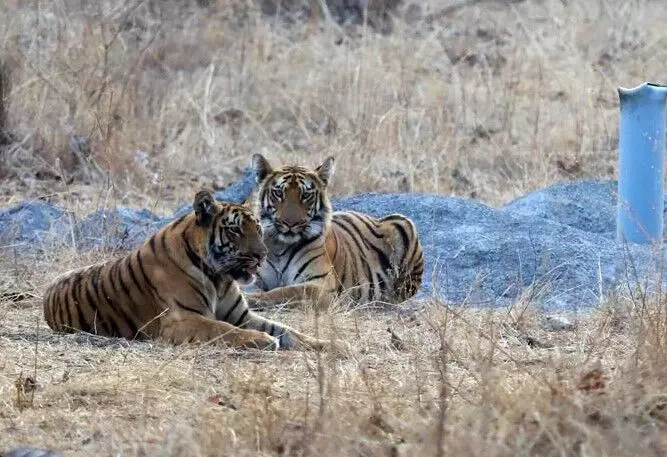Tiger population in Maharashtra expands to Kagaznagar; Telangana prepares to curb attacks on humans
As many as 30 persons have lost their lives in attacks by tigers and an almost similar number of tigers have been lost in the area in 2024
By S. Harpal Singh
Big cats in Kagaznagar forests
Adilabad: Chandrapur district in Maharashtra is the country's epicentre of human-tiger conflict. As many as 30 persons have lost their lives in attacks by tigers and an almost similar number of tigers have been lost in the area in 2024.
Conservation measures
This gloomy news, however, conceals a great success story in tiger conservation, one which has come to impact conservation efforts in north Telangana forests adjoining the Chandrapur and Gadchiroli districts of Maharashtra.
The highly successful conservation measures undertaken by the Maharashtra Forest Department resulted in the famous Tadoba-Andhari Tiger Reserve (TATR) boasting a tiger population of around 100 and an equal number of big cats roaming the thick dry deciduous forests outside the park.
The last few months saw five or six tigers wandering into the erstwhile unified Adilabad district, especially the Kagaznagar forests in Kumram Bheem Asfabad district from Maharashtra including one from the Bor Tiger Reserve in Wardha district. These tigers are giving sleepless nights to humans in habitations wherever these tigers are moving and to the forest department which needs to monitor the movement.
Four big cats in Kagaznagar forests
At present, four big cats are said to be moving in Kagaznagar forests. A male and a female from TATR are said to be in Sirpur (T) forest near the interstate border.
Another female is said to be somewhere in Tiryani forests and a resident female identified as K8 is assumed to be moving in Penchikalpet forests. The tigers being highly mobile may enter new territory in the next few days.
The male tiger from TATR has killed one human and another person escaped with injuries in a separate attack by the same tiger. These tigers have killed a few cattle too while on the prowl.
Spillover population
"There is a surplus population of tigers in Tadoba and Brahmapuri forests in Maharashtra and those travelling to this side of the border constitute a spillover population. The tiger corridor leading to Kagaznagar forests is comparatively less populated by humans which could be an important reason why the Maharashtra tigers are coming here," said Hyderabad-based wildlife expert Sanjeev Siva.
Facilities for big cats
On the question of tigers returning to Maharashtra forests instead of going resident in Kagaznagar or Kawal Tiger Reserve further south, the well-known wildlife expert said the basic requirements to make a habitat conducive for the big cats are developing water sources within the forest, grassland management and availability of sufficient prey in addition to lesser human activity.
The grasslands will ensure the population of deer is at an ideal level which is key to decreasing conflict with humans by way of sparing cattle and deciding to stay back in the new territory, he added.
Among the most important factors that can define the success of tiger conservation initiatives is the control of poaching, especially that of deer and other ungulates. Monitoring of villages lying on forest fringes is essential to control poaching.
Sanjeev Siva, nevertheless, pointed out the uncertainties that influence tiger conservation. "Even if all factors are in place, it is the choice of the individual tiger to go resident as we cannot stop a free-thinking animal," he quipped.